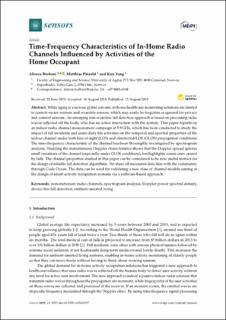Time-Frequency Characteristics of In-Home Radio Channels Influenced by Activities of the Home Occupant
Peer reviewed, Journal article
Published version

View/
Date
2019Metadata
Show full item recordCollections
Original version
Borhani, Al., Pätzold, M. U. & Yang, K. (2019). Time-Frequency Characteristics of In-Home Radio Channels Influenced by Activities of the Home Occupant. Sensors, 19(16). doi: 10.3390/s19163557Abstract
While aging is a serious global concern, in-home healthcare monitoring solutions are limited to context-aware systems and wearable sensors, which may easily be forgotten or ignored for privacy and comfort reasons. An emerging non-wearable fall detection approach is based on processing radio waves reflected off the body, who has no active interaction with the system. This paper reports on an indoor radio channel measurement campaign at 5.9 GHz, which has been conducted to study the impact of fall incidents and some daily life activities on the temporal and spectral properties of the indoor channel under both line-of-sight (LOS) and obstructed-LOS (OLOS) propagation conditions. The time-frequency characteristic of the channel has been thoroughly investigated by spectrogram analysis. Studying the instantaneous Doppler characteristics shows that the Doppler spread ignores small variations of the channel (especially under OLOS conditions), but highlights coarse ones caused by falls. The channel properties studied in this paper can be considered to be new useful metrics for the design of reliable fall detection algorithms. We share all measured data files with the community through Code Ocean. The data can be used for validating a new class of channel models aiming at the design of smart activity recognition systems via a software-based approach.
